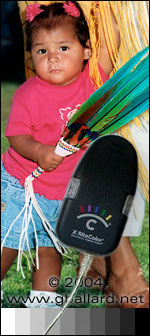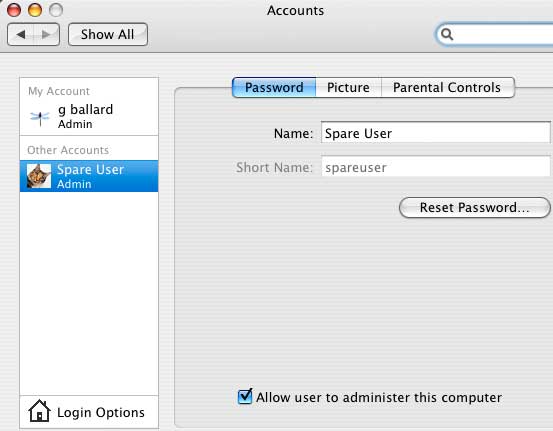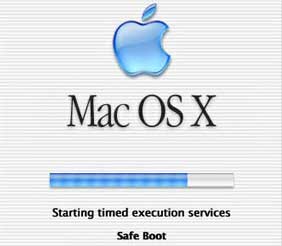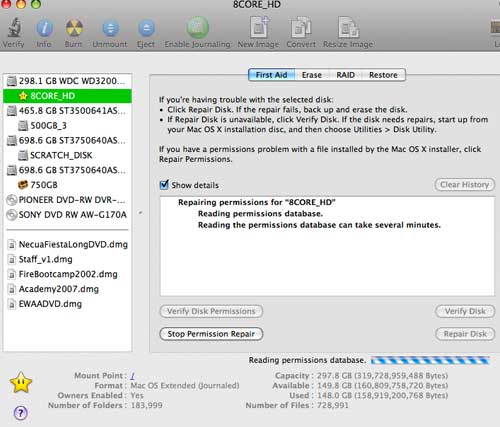|
Mac OS X By © 2005-2014 G. BALLARD, a professional Mac work-flow consultant in San Diego, CA
My free online basic troubleshooting guide shortcuts: CORRUPTION | BACKUP | FREE UNUSED SPACE | DEFRAG | VIRUSES | SPARE USER ACCOUNT | PREFERENCES | SAFE BOOT | DISK UTILITY REPAIR PERMISSIONS | DISK UTILITY REPAIR DISK | DISK WARRIOR | MAC CLEANER APPS (Slow Mac) | FSCK | CRON SCRIPTS | COMBO UPDATES | FAQ-TIPS | TIME MACHINE-CLONING | STARTING OVER | NEW TO MAC LINKS When Mac a computer starts running slow or acting flaky — unstable, crashing, freezing or generally misbehaving — it's a corruption issue 98 percent of the time (unless we've recently done something to it, and there is 98 percent of our clue). After I've ruled out the two-percent conflict by removing whatever I recently added or updated and rebooted to see if that resolved the problem, I will start with the Mac OSX basics: FIRST, before we start any troubleshooting or System or hard drive maintenance procedures, it is important that we BACK UP OUR DATA to other drives or CD or DVD media. This is important because the disk may be hanging on by a thread and the most basic procedure may lose the drive and data forever.
SECOND, be sure you have a lot of free unused disk space on your hard drives (a minimum 30 percent of free unused, unfragmented space is recommended) — a hard drive that fills up and turns flaky is nearly impossible (for me) to get back to normal without Erasing reformatting.
DEFRAGGING a boot hard disk is generally a Windows "PC" thing, but we Apple Mac users do need to watch how we manage our data.
It has been widely stated on the internet and Apple forums there are no known computer viruses for the Mac OSX operating system — so worrying about getting a virus is probably needless worry for most of us — search Google for more facts and information about Mac viruses, Trojans, prevention. What we do need to watchout for is passing infected files that we download or receive in emails over to Windows users where they can do serious damage. APPLE'S OS-X VIRUS SECURITY INFORMATION. MAC ONLINE VIRUS GUIDE by Thomas A. Reed. FREE Mac OS-X VIRUS SOFTWARE DOWNLOAD: www.clamxav.com. #1 Tip Create a New "Spare User" Account:
Create a new SPARE USER with ADMIN privileges (System Preferences> System> Accounts). A fresh NEW USER ACCOUNT gives us a new, clean, untouched set of User Preferences to work with and trouble shoot — this is usually the first move I make in troubleshooting because it resets all applications to default (in case I have set a bad preference), and it also rules out any whacky or corrupted user Preferences. Then, WHEN something isn't working correctly
If the problem prevents us from logging into our user account, but can still login to Spare User, I would suspect a conflict or preference associated with my Log In items (disable login items if you can get logged in, or navigate to the login System or User preference "loginwindow.plist" and trash it). Troubleshooting Preference Files:If our user account is corrupted (problem clears in Spare User), the first thing to consider is a damaged preference file in our normal user account. One workflow technique is to have previously backed up our Preferences folder. Then we simply start swapping the suspect preferences with our back ups. Or else we start trashing the most likely preferences and rebooting or logging out/in.... Another troubleshooting technique is to drag our user entire Preferences folder out of the our user Library and onto the Desktop. Then Log Out and back into our user account. If the problem has cleared, one of the old Preferences is bad (we can continue replacing the new with the until the problem returns and nails the bad preference file). It may be easier to just make a new account and trash the corrupted one, though, which is probably what I would do. Hold down Shift for a "Safe Boot": Starting with 10.2 Jaguar, Mac OS X features a "Safe Boot/Safe Mode." Safe Booting -- rebooting from a complete ShutDown with Shift key down -- forces a directory check of the boot volume and loads only required kernel extensions and Apple start-up items. From Apple's SAFE BOOT article:
Run Disk Utility's Repair Permissions:
Starting with 10.2 Jaguar, Mac OS X features a Repair Permissions routine located in Hard Drive> Applications> Utilities> Disk Utility> First Aid. PERMISSIONS REPAIR is to be ran from the boot OS System while booted from that system. In other words, navigate to Disk Utility and run Repair Permissions on the boot hard drive. Run Disk Utility's Repair Disk: As Lion 10.7.0 released today, I am not sure how to run Disk Utility REPAIR DISK since Lion is an Apple DOWNLOAD only, and you need 10.6 installed to download 10.7.... See above screen picture for panel for Repair Disk, highlighting any non boot volume or hard drive will active the Repair Disk option. Repairing the BOOT hard drive or volume REQUIRES us to boot from another disk, hard drive, hard disk or removable disk Apple's technical article TS1417 on running Disk Utility REPAIR DISK:
Repairing other non-boot drives or volumes:
Booting in Single User Mode and Running fsck -fy (this process seems to change a bit with updates, check the linked Apple articles carefully for more info): WHAT IS FSCK? Apple tech article states that Disk Utility Repair Disk is the same as running as fsck, yet many users have said they prefer fsck -fy from a Shut Down. In the linked Apple tech article, Apple states, "Important: If you're using Mac OS X 10.4 or later, you should use Disk Utility instead of fsck, whenever possible." In any case, we do NOT need an Apple boot Install CD or DVD to run fsck -fy. Here's how to do fsck -fy:
DISK WARRIOR — 3rd Party Disk Utilities If Apple's REPAIR DISK and FSCK-Y cannot repair the problem, we need to try third-party DISK UTILITIES like Disk Warrior alsoft.com. But BEWARE of 3rd-party disk utilities, especially running Norton Utilities on OS X disks because Norton is not compatible with them (search GOOGLE for the OSX-Norton issues). Warning: NEVER USE NORTON DISK UTILITIES on an OS X hard drive. I know a lot of people recommend running DISK WARRIOR on healthy, properly-functioning boot drives — including system/applications hardrives that may need only minor repairs or routine maintenance — but I only recommend using Disk Warrior as a last resort AFTER everything has been properly backed up to other disks. I say this because it makes more comonsense to let Apple's Disk Utility maintain the Operating System and boot drive, rather than some extreme third-party disk utility — in the four or five times I have used Disk Warrior in the past several years, it was to repair problems Disk Utility couldn't fix (and it is a very useful tool for that). Cron Scripts-maintenance: If the Macintosh doesn't run 24/7, or if it is set to sleep at night — I run Cocktail regardless — we should look into a utility like COCKTAIL to manually perform the usual daily/weekly/monthly UNIX maintenance scripts that the operating system enables to clean up the Mac during the wee AM hours of the morning. Cocktail OSX is a general purpose utility for Mac OSX that will run cron scripts (among other things). In Cocktail's settings, I always setup #2: Clear selected caches> Options> User: Clear all Font Caches BECAUSE Snow Leopard seems prone to corrupting its font caches. More on troubleshooting font problems: see ADOBE ARTICLE. So-called Mac system and hard drive cleaner apps that purport to optimize, organize and/or speed up your "slow" computer by sweeping or cleaning out junk and unused files are to be avoided -- in my experience -- they can do more damage than good even for expert users. Many bloggers and respected websites are accusing some of these apps as malware -- if you are thinking of trying one out, please add "malware" to a product name search before downloading it. If you must try it, I recommend creating a restorable backup clone of your hard drive before installing it. SLOW MAC: If a Mac computer, iPhone, iPod or iPad tablet is running slow, I would recommend:
I am trying to filter these "cleaner" apps from appearing in my ADs, but use them at your own discretion. Running Apple's COMBO System Updaters: System Preferences> Software Update can be flaky so a proven troubleshooting technique is to manually download Apple's COMBO UPDATES (PPC & INTEL). The 10.6.8 10.4.11 10.5.8 Combo Update, for example, can be installed right on top of an existing 10.7, 10.4.11 or 10.5.8, 10.6.8 install. Just go to APPLE.COM/DOWNLOADS and download the latest "COMBO" updater for your Operating System. Search tip: enter "combo" in your search on Apple's download page. The advantages or pros of using the Combo Updates is it goes in and replaces the updated parts of the system. The con is the Combo Updates are usually well over 700MB to download. Again, running a Combo Updater is something to try before giving up on a flaky installed system.... +++++ FREQUENTLY ASKED QUESTIONS FAQ KEYBOARD SHORTCUTS PLUS USEFUL WHY ABOUT HOW TO INFORMATION, TIPS On USING MAC OSX:
For help with troubleshooting Adobe Photoshop. For help evaluating and troubleshooting monitor color problems, bad color. For help with troubleshooting Mac OS 9. For help with troubleshooting FONT ISSUES. Backing Up is likely the most important point of this article and it is so easy these days that even casual users can learn how to make restorable back ups with minimal effort — so take a few minutes to figure out what backing up computers is all about. The point is: WHEN an install starts acting flaky or the hard drive actually dies, simply replace and Erase-reformat the hard drive, and RESTORE it back to a trustworthy state — but we will need to have already backed up or cloned the install to restore a working bootable system. We may also pull good Preferences from cloned drives (so our Preferences are backed up in the process). It is easy to drag a set of Photoshop preferences out of the cloned back up and copy them over to a working install, for example, if you dread re-configuring or troubleshooting Adobe Photoshop preferences. What is a cloned hard drive?: A cloned hard drive is an exact bootable copy, a mirror image, of source hard drive. Typically that means my working boot drive with all my applications installed, and all my preferences set up. A cloned drive will boot and/or restore another drive EXACTLY as its original source drive. This means — if my working boot drive fails, I can swap it with the cloned hard drive and get right back to work in a few minutes. I can also use my backup cloned hard drive to RESTORE a freshly-formatted hard drive and get back to work in an hour or so on my fully-tuned working restored hard drive. How to Back Up or Clone a boot system-applications hard drive: I have only used Carbon Copy Cloner CCC and it has worked so flawlessly for me that I haven't tried other backup options under OS X, including Super Duper application (that many people recommend on the Apple forums) and Apple's own Time Machine.app that is included with Snow Leopard SL 10.6 and Leopard 10.5x. Here is Apple's official Knowledge Base article HT1427: "Learn how to set up Time Machine to perform backups, how to restore items (or your entire system) from a backup, how to use existing backups on a new Mac, and more." When to back up?: I make my first clone right after I have installed my main applications, ran all the updaters, and set all their preferences, but if your install is running stable now, NOW is the time to back up your bootable system hard drive BEFORE you have to learn this lesson the Hard Way! I generally make a second clone after I have installed minor applications like bookkeeping and font management apps, printer and scanner drivers, system haxies, games, and plug-ins. There is one work flow I should mention — how I use Carbon Copy Cloner — I boot off a third "maintenance" hard drive, launch Carbon Copy Cloaner, and select my Source and Target hard drives (using three drives in the process).
WORK-FLOW TIPS: I prefer to keep data files (Music, Pictures, font libraries, Documents, backups) on other drives so the boot drive keeps only system and application files. This keeps my system backup small and apart from my data files:
I prefer to make full complete cloned system hard drive clones versus incremental backups (like how Time Machine app works). The bottom line is create the types of backups you understand and use the workflows that fit your needs, but take a few minutes now to figure out and setup a back-up strategy in place. STARTING OVER Some people fear initializing, reformatting, erasing their computer and starting over with a clean install. My experience is that spending two or eight hours reinstalling everything is a lot better than wasting days, weeks, months pulling hair out and losing work on a corrupted system or bad hardware. One very useful TIP I use for a fast answer is to Erase the Photoshop Scratch Disk or another HD, and TEMPORARILY install OSX, run the OSX updaters and install only the suspect application -- this takes about two hours and will generally rule out corruption on the normal boot drive by booting off a new fresh system...an external FireWire hard drive works fine for this fire drill. For my MELTDOWN procedure help with preparing a Mac for AASP (Authorized Apple Service provider) and reformating an Erase Start From Scratch hard drive install. New to the Mac operating system? Mac OS-X aka OS-10, Tiger 10.4, Leopard 10.5, Snow Leopard 10.6 is the Mac Operating System. These OS-X operating systems are equivalent to Microsoft® Windows® operating systems like Windows XP, Windows Vista, and Windows 7. HERE ARE A COUPLE GREAT APPLE LINKS FOR SWITCHERS: Mac 101 Getting Started with the Mac Switch 101 Migrate to the Mac Anatomy of a Mac - Find Out How Mac 101: Time Machine Apple Mac Quick Assist Switch to a Mac Here are the community Apple FORUMS. +++++ July 20, 2011: As Apple's new Operating System "LION" (10.7) released today as a $29.95 upgrade — DOWNLOAD ONLY from Apple's App Store (you can't buy actual 10.7 Apple Install disks, but you may purchase the 10.7 Installer on a Thumb Drive directly from Apple for $69), or burn your own Lion Install DVD from the download. Here is how to install Lion 10.7 from scratch, including reformatting and Erasing a new hard drive and starting over from scratch on a new harddrive, and using the Lion Installer on an existing 10.6 system:
So with no OS Lion 10.7 Install boot disk:
WARNING TO THE BRAVE SOULS UPGRADING TO APPLE'S NEWEST Operating System, currently 10.9 Mavericks Lion. There are good reasons experienced users avoid brand new Operating Systems, but if you must be on "The Bleeding Edge" consider my free advice for what it may be worth to you:
|
 TROUBLESHOOT & confirm monitor profiles. 
|
||
|
by: ©2005-2014 G. BALLARD • www.gballard.net Please read the www.gballard.net site USER AGREEMENT, and site DISCLAIMER for legal issues regarding your use of the www.gballard.net site. G. Ballard, www.gballard.net, receives no compensation from, and is not affiliated with Apple Computers, Inc. Terms of Use • Privacy Statement • Site Map |



